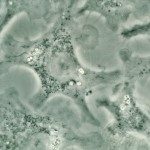Link to Pubmed [PMID] – 25392997
PLoS Negl Trop Dis 2014 Nov;8(11):e3308
DNA sequences purified from distinct organisms, e.g. non vertebrate versus vertebrate ones, were shown to differ in their TLR9 signalling properties especially when either mouse bone marrow-derived- or human dendritic cells (DCs) are probed as target cells. Here we found that the DC-targeting immunostimulatory property of Leishmania major DNA is shared by other Trypanosomatidae DNA, suggesting that this is a general trait of these eukaryotic single-celled parasites. We first documented, in vitro, that the low level of immunostimulatory activity by vertebrate DNA is not due to its limited access to DCs’ TLR9. In addition, vertebrate DNA inhibits the activation induced by the parasite DNA. This inhibition could result from the presence of competing elements for TLR9 activation and suggests that DNA from different species can be discriminated by mouse and human DCs. Second, using computational analysis of genomic DNA sequences, it was possible to detect the presence of over-represented inhibitory and under-represented stimulatory sequences in the vertebrate genomes, whereas L. major genome displays the opposite trend. Interestingly, this contrasting features between L. major and vertebrate genomes in the frequency of these motifs are shared by other Trypanosomatidae genomes (Trypanosoma cruzi, brucei and vivax). We also addressed the possibility that proteins expressed in DCs could interact with DNA and promote TLR9 activation. We found that TLR9 is specifically activated with L. major HMGB1-bound DNA and that HMGB1 preferentially binds to L. major compared to mouse DNA. Our results highlight that both DNA sequence and vertebrate DNA-binding proteins, such as the mouse HMGB1, allow the TLR9-signaling to be initiated and achieved by Trypanosomatidae DNA.


